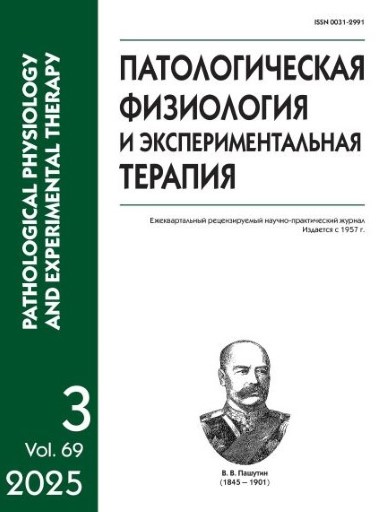Characteristics of the erythron in rats with experimental benign prostatic hyperplasia
Abstract
Aim: to determine the features of erythropoiesis in rats with experimental benign prostatic hyperplasia (BPH) induced by long-term sulpiride administration.
Methods. Experimental model of BPH: rats were administered sulpiride 40 mg/kg, IM, daily for 30 days. The peripheral erythron component (erythrocyte and reticulocyte count and erythropoietin level) was determined in the blood. The condition of the central erythron component was assessed by the quantitative and qualitative composition of erythroblastic islets (EI). The total number of EI was counted in a Goryaev chamber. After Pappenheim staining, the EI distribution by maturity classes was examined.
Results. In rats with BPH, the blood serum content of erythropoietin was decreased by 1.3 times, but the count of erythrocytes and reticulocytes did not differ from the control. The total number of EI in the bone marrow of rats with BPH did not differ from the control, but de novo erythropoiesis completely stopped (maturity class 1 EI disappeared). The number of maturity class 2 islets decreased by 3.3 times, and the number of reconstructing islets increased by 1.4 times. Mature EI (class 3 and involuting EI) remained at the control level.
Conclusion. Long-term administration of sulpiride, which induces prolactin hypersecretion, facilitates the stimulation of erythropoiesis reconstruction in the bone marrow, which is apparently caused by tissue erythropoietin produced by bone marrow macrophages. This stimulation of erythropoiesis reconstruction maintains the number of erythrocytes in the peripheral blood of rats with BPH at a physiological level.
Downloads
References
2. Harchenko M.F., Kornilova N.V., Zaharov YU.M., Bityukova E.S. Glikozaminoglikany eritroblasticheskih ostrovkov kostnogo mozga krys. Fiziologicheskij zhurnal im. I.M. Sechenova. 1994; 80(11): 32-6.
3. Tishevskaya N.V., Zakharov Yu.M., Tishevskoy I.A. Effect of erythropoietin in various concentrations on the culture of erythroblastic islets. Russ. J. Physiol. 1998; 84 (12): 1412-19.
4. Tishevskaya N.V., Shevyakov S.A., Zakharov Yu.M. The effect of humoral factors on phagocytic activity of central macrophages in the erythroblast islet culture. Russ. J. Physiol. 2002; 88(9): 1191-8.
5. Tishevskaya N.V., Shevyakov S.A., Zakharov Yu.M. Vliyaniye eritropoetina i makrofagal'nogo koloniyestimuliruyushchego faktora na proliferativnuyu aktivnost' eritroidnykh kletok v kul'turakh eritroblasticheskikh ostrovkov. Meditsinskiy akademicheskiy zhurnal. 2003; 3(3): 67-72.
6. Volchegorskii I.A., Tishevskaya N.V., Dement'eva E.V. Antianemic effect of reamberin in rats with acute alloxan-induced diabetes. Eksperimental'naya i klinicheskaya farmakologiya. 2008; 71(6): 23-7.
7. Gevorkyan N.M., Tishevskaya N.V., Bolotov A.A. Effect of preliminary administration of total RNA of bone marrow cells on the dynamics of erythropoiesis recovery in rats after acute gamma irradiation. Bulletin of experimental biology and medicine. 2016; 161(5): 670-673. DOI: 10.1007/s10517-016-3494-z.
8. Socolovsky M., Dusanter-Fourt I., Lodish H.F. The prolactin receptor and severely truncated erythropoietin receptors support differentiation of erythroid progenitors. J. Biol. Chem. 1997; 272(22): 14009-12. DOI: 10.1074/jbc.272.22.14009.
9. Bellone G., Astarita P., Artusio E., Silvestri S., Mareschi K., Turletti A., Buttiglieri S., Emanuelli G., Matera L. Bone marrow stroma-derived prolactin is involved in basal and platelet-activating factor-stimulated in vitro erythropoiesis. Blood. 1997; 90(1): 21-7.
10. Bellone G., Geuna M., Carbone A., Silvestri S., Foa R., Emanuelli G., Matera L. Regulatory action of prolactin on the in vitro growth of CD34+ve human hemopoietic progenitor cells. J. Cell Physiol. 1995; 163(2): 221-31. DOI: 10.1002/jcp.1041630202.
11. Zhang W.C., Sun R., Zhang J., Zhang J., Tian Z. Recombinant human prolactin protects against irradiation-induced myelosuppression. Cell Mol. Immunol. 2005; 2(5): 379-85.






